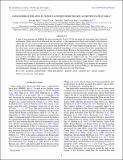FERMI BUBBLES INFLATED BY WINDS LAUNCHED FROM THE HOT ACCRETION FLOW IN SGR A*
Author(s)
Mou, Guobin; Yuan, Feng; Bu, Defu; Sun, Mouyuan; Su, Meng
DownloadMou-2014-Fermi bubbles inflat.pdf (1.494Mb)
PUBLISHER_POLICY
Publisher Policy
Article is made available in accordance with the publisher's policy and may be subject to US copyright law. Please refer to the publisher's site for terms of use.
Terms of use
Metadata
Show full item recordAbstract
A pair of giant gamma-ray Bubbles has been revealed by Fermi-LAT. In this paper we investigate their formation mechanism. Observations have indicated that the activity of the supermassive black hole located at the Galactic center, Sgr A*, was much stronger than at the present time. Specifically, one possibility is that while Sgr A* was also in the hot accretion regime, the accretion rate should be 10[superscript 3]-10[superscript 4] times higher during the past ~10[superscript 7] yr. On the other hand, recent magnetohydrodynamic numerical simulations of hot accretion flows have unambiguously shown the existence and obtained the properties of strong winds. Based on this knowledge, by performing three-dimensional hydrodynamical simulations, we show in this paper that the Fermi Bubbles could be inflated by winds launched from the "past" hot accretion flow in Sgr A*. In our model, the active phase of Sgr A* is required to last for about 10 million years and it was quenched no more than 0.2 million years ago. The central molecular zone (CMZ) is included and it collimates the wind orientation toward the Galactic poles. Viscosity suppresses the Rayleigh-Taylor and Kelvin-Helmholtz instabilities and results in the smoothness of the Bubbles edge. The main observational features of the Bubbles can be well explained. Specifically, the ROSAT X-ray features are interpreted by the shocked interstellar medium and the interaction region between the wind and CMZ gas. The thermal pressure and temperature obtained in our model are consistent with recent Suzaku observations.
Date issued
2014-08Department
Massachusetts Institute of Technology. Department of Physics; MIT Kavli Institute for Astrophysics and Space ResearchJournal
Astrophysical Journal
Publisher
Institute of Physics/American Astronomical Society
Citation
Mou, Guobin, Feng Yuan, Defu Bu, Mouyuan Sun, and Meng Su. “ FERMI BUBBLES INFLATED BY WINDS LAUNCHED FROM THE HOT ACCRETION FLOW IN SGR A* .” The Astrophysical Journal 790, no. 2 (July 10, 2014): 109. © 2014 The American Astronomical Society.
Version: Final published version
ISSN
0004-637X
1538-4357